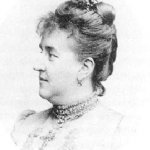Helena Munktell (1852–1919)
Pianist and composer. Made a name for herself as a copmoser with her debut consert in 1995, where she performed some of her own pieces. Studied for Vincent d’Indy, Johan Lindegren, and composition for Ludwig Norman; also studied in Paris in 1877–1879. It was also in Paris that she was most successful, as her daring use of harmony was considered too difficult in Sweden.
Stilistically, her music has ties to neo-Romanticism. Her ballad Isjungfrun for baritone and orchestra (1889) was performed in Paris; her opera I Firenze played in Paris in 1889 and is considered the first opera by a Swedish woman composer. Munktell was elected to the Swedish Royal Academy of Music in 1915 and was a founding member of the Society of Swedish Composers.
At her debut consert, her pieces was likened to musical pearls, “rich in surprising turns, staying close to the main key, but with chords that are full of variety, using many suspensions, passing tones, and other decorations in the French style.” Her bold harmonies were considered difficult in Sweden and Germany; it would be France where she reaped her greatest successes. In 1895 came the first performace of her richly chromatic orchestral work Bränningar, op. 19, in Monte Carlo. In 1899 the baritone ballad Isjungfrun (written in 1889) was performed in Salle Pleyel in Paris, to much acclaim. During this period d’Indy was working hard to promote her music. The violin sonata in E-flat major, op. 21, was premiered by Georges Enescu in Paris and also received successful performances in Berlin. Munktell also composed a cantata for the dedication of the Swedish Church in London in 1911.
In Stockholm, her opéra comique I Firenze was performed in 1889, the first opera written by a Swedish woman composer (althought the instrumentation at that point was still done by Joseph Dente). Although her strong orientation towards France brought new impuses to Swedish music, by the end of her career she was also inspired by Nordic national Romanticism. This is clearly evident in, for instance, her Dalsvit, op. 22 (f.p. Paris, 1910) and her Valborgsmässoeld, op. 24 (1910), both of which take up motifs from her childhood home of Dalarna.
(Stig Jacobsson)
Recordings: Orchestral works (Gävle Symphony Orchestra, Tobias Ringborg), Sterling Qualiton
Music example:
Bränningar. Gävle Symphony Orchestra



